Winter Snuggles |
||||||||||
 |
 |
|||||||||
Jacket, trousers, hat, mittens, socks and blanket in Alpaca
DROPS Baby 13-5 |
||||||||||
|
Knitting tension, all garments: 24 sts x 32 rows on needles size3mm in stocking sts = 10 x 10 cm. JACKET: Rib: *K2, P2*, repeat from *-*. Garter sts (back and forth on needle): Knit all rows Pattern: See diagrams M.1 to M.4. The diagrams show the pattern from the right side. Front and back piece: Knit the jacket back and forth on circular needle from mid front. Cast on 144-160-172 (200-212) sts (incl 1 edge st towards mid front each side, knitted in garter sts throughout) with Alpaca on circular needle size 2.5mm. Knit 1 row from the wrong side and continue in Rib with 1 edge st and 2 further sts in garter sts towards mid front (seen from the right side). When Rib measures 3-4-4 (5-5) cm, change to circular needle size 3mm. Knit 1 row from the right side, at the same time adjusting number of sts evenly to 123-135-147 (171-183). Now purl 1 row from wrong side and knit 1 row from right side. Insert a marking thread 31-34-37 (43-46) sts in from each side = 61-67-73 (85-91) sts between marking threads on back piece – let the marking threads follow the piece as you progress. Knit M.1 with 1 edge st each side and knit next row as follows: 1 edge st, M.2A over the next 108-120-132 (156-168) sts, M.2B (= 13 sts), 1 edge st. Continue like this. Read all of the following section before knitting it! When piece measures approx 15-17-21 (25-28) cm – adjust after 2 rows with off-white after 1 row with pattern - continue in M.3 in the same way, i.e. 1 edge st, M.3A over the next 108-120-132 (156-168) sts, M.3B (= 13 sts) and 1 edge st. At the same time, when piece measures 17-18-21 (24-26) cm split the piece for armholes by both marking threads and finish back and front pieces separately. Back piece: = 61-67-73 (85-91) sts. Cast on 1 new st each side (= edge st for seam) = 63-69-75 (87-93) sts. Continue in M.3 with 1 edge st each side. When piece measures 27-29-33 (37-40) cm cast off the middle 21-23-25 (25-27) sts for neck. Dec 2 sts on neckline on next row = 19-21-23 (29-31) sts left on shoulder. Cast off remaining sts after M.3, piece measures approx 28-30-34 (38-41) cm. NB! If piece is shorter continue in off-white until finished measurements. Left front piece: = 31-34-37 (43-46) sts. Cast on 1 new st towards armhole (= edge st for seam) = 32-35-38 (44-47) sts. Continue in M.3 with 1 edge st each side. At the same time, when piece measures 24-26-29 (33-35) cm put the 7-8-9 (9-9) sts towards mid front on thread for neck. Now dec to shape the neckline on every other row: 2 sts 2 times and 1 st 2-2-2 (2-3) times = 19-21-23 (29-31) sts left on shoulder. Cast off when piece measures the same as back piece. Right front piece: Knit as left front, but mirrored. Sleeve : Read all of this section before knitting it! Cast on 48-53-56 (60-64) sts with off-white Alpaca on double pointed needles size 2.5mm and knit 1 round. Continue in Rib. When piece measures 5 cm, insert a marking thread – measure piece from here, continue in Rib for 5 more cm (= rib measures 10 cm from cast on edge)- and change to needle size 3mm. Knit 1 round whilst adjusting number of sts to 40-42-44(46-48). Purl 1 round, knit 1 round and continue in M.1 – adjust the middle, see arrow in diagram. After M.1 continue in M.2 (adjust middle after arrow) until piece measures 16-17-19 (23-27) cm. Now knit M.4. At the same time when piece measures 7 cm inc 2 sts mid under arm a total of 7-8-9 (11-12) times: Size 1/3 + 6/9 + 12/18 months + 2 years: on every 5th round Size 3/4 years: on every 6th round = 54-58-62 (58-72) sts – incorporate new sts in pattern as you go along. After M.4 cast off loosely, piece measures approx 19-20-22 (26-30) cm from marking thread. NB! If piece is shorter continue in off-white until finished measurements. Assembly: Sew shoulder seams. Front edge: Pick up 74-78-86 (94-102) sts along left front piece with off-white and needle size 2.5mm. Knit 1 row from wrong side and 1 row from right side. Continue in Rib with 2 sts in garter sts and 2 knitted sts each side (seen from the right side). When Rib measures 2.5 cm cast off in rib. Repeat along right front piece but when Rib measures approx 1 cm, make 5-5-5 (6-6) buttonholes evenly distributed – the lower one approx 1 cm from lower edge and the top one approx 4-6 cm from neckline (the last buttonhole will be on the neckline). 1 buttonhole: cast off 2 purled sts from the right side and cast on 2 new sts on next row. Neckline: Pick up approx 86 to 110 sts, incl sts on threads on front pieces (number of sts should be dividable by 4 + 2) round neck and front edges with off-white Alpaca and needle size 2.5mm. Knit 1 row from wrong side and 1 row from right side and continue in Rib with 2 sts in garter sts and 2 knitted sts each side (seen from the right side). When rib measures 1 cm make a buttonhole over the others on right front edge (knit tog 3rd and 4th st from edge and make a yo). When rib measures 3-4-4 (5-5) cm make another buttonhole and when neckline measures 4-5-5 (6-6) cm cast off in rib. Fold neckline double towards the wrong side and attach with neat sts on wrong side. Sew in sleeves and sew on buttons. Fold the rib on sleeves towards the right side. _________________________________________ TROUSERS: Rib: *K2, P2*, repeat from *-*. Pattern: see diagrams M.1 and M.2. The whole pattern is knitted in stocking sts. Buttonhole: Make 2 buttonholes at front with approx 8-9-10 (11-12) cm between each. 1 buttonhole: cast off 2 purled sts from right and cast on 2 new sts on next row. Decreasing tips (applies to inner side of leg): Dec as follows 1 st before the marking thread: K2 tog Decrease as follows 1 st after the marking thread: slip 1 st as if to knit, K1, psso. Start at the top and knit downwards. Cast on 160-168-176 (184-192) sts with off-white and circular needle size 2.5mm. Purl 1 round (round starts and finishes mid back). Continue in Rib. When Rib measures 2 cm, make 2 buttonholes at front – see above. When piece measures 4 cm insert a marking thread mid front (= folding edge) and measure piece from here from now on. When piece measures 2 cm, make 2 buttonholes as before (they have to fit over the first 2 when folding the edge double). When Rib measures 4 cm change to needle size 3mm. Knit 1 round, at the same time dec evenly to 114-120-126 (132-138) sts. Purl 1 round and knit 1 round. Elevation at the back: Knit M.2A, at the same time knitting elevation at the back as follows: knit 9-10-10 (11-11) sts from beginning of round, turn the piece (to avoid a hole slip the first st as if to knit and tighten thread when knitting back), knit 18-20-20 (22-22) sts, turn the piece. Continue like this by knitting 9-10-10 (11-11) sts more before each turn another 10 times (= 12 rows). Now knit M.2A round over all sts. Increases: When piece measures 13-16-17 (18-19) cm (measured from marking thread mid front) insert a new marking thread at beginning of round and after 57-60-63 (66-69) sts. Inc 1 st on each side of these marking threads (= 4 inc per round) on every 3rd round a total of 6 times = 138-144-150 (156-162) sts. After the last inc the piece measures approx 18-21-22 (23-24) cm mid front. Legs: Knit 69-72-75 (78-81) sts from mid back (= leg) and put remaining sts on a thread. Knit round and continue M.2A as before. Insert a new marking thread at beginning of round (= inner side of leg). Dec 1 st on each side of marking thread - see decreasing tips – a total of 13-12-11 (11-11) times: Size 1/3 months: on every 3rd round Size 6/9 months: on every 4th round Size 12/18 months: on every 5th round: Size 2 years: on every 7th round Size 3/4 years: on every 8th and 9th alternately = 43-48-53 (56-59) sts. When piece measures approx 30-36-40 (46-52) cm – adjust after 2 rounds of off-white after a round of pattern – knit M/1 - start at the top of diagram and see arrow which marks the middle of round (= outer side of leg). After M.1 change to off-white and needle size 2.5mm. Knit 1 round, at the same time adjusting number of sts to 68-72-76 (80-84). Knit 10 cm Rib and cast off loosely. Knit the other leg in the same way. Assembly: Fold rib at the top of the trousers down on the inside of the garment. Make sure the buttonholes fit over each other. Fasten rib on the inside of the garment. To avoid the rib being too tight it is important to make the seam elastic. Braces: Cast on 12 sts on needle size 2.5mm with off-white and knit Rib with 1 edge st and a further 2 sts each side in garter sts (seen from the right side). Cast off when piece measures approx 34-40-48 (58-64) cm. Make two and sew to back of trousers (on the inside of rib) with approx 8-9-10 (11-12) cm in between. Sew on buttons to front end of braces and cross braces at back when worn. _________________________________________ HAT: Size: 1/3 – 6/9 – 12/18 months (2 - 3/4 years) To fit head circumference: 40/42 – 42/44 – 44/46 (46/48 - 48/50) cm Pattern: See diagram M.2. The whole pattern is knitted in stocking sts. The hat is knitted round. Loosely cast on 112-116-120 (124-132) sts with off-white Alpaca on needles size 2.5 mm and purl 1 round. Now knit 10 cm Rib, K2/P2, and change to needle size 3mm and stocking sts and M.2A, at the same time adjusting number of sts to 90-96-102 (108-114). When piece measures 17-17-18 (19-20) cm insert 6 marking threads in piece with 15-16-17 (18-19) sts between each. Continue in M.2A, at the same time dec 1 st on each side of all marking threads (see Decreasing tips under trousers): on every other row 6-7-7 (6-6) times and then on every row 0-0-0 (2-2) times = 18-12-18 (12-18) sts left – knit sts not fitting into pattern when decreasing in off-white. Pull a double strand of Alpaca through the remaining sts, pull tight and attach. Fold the lower 5 cm Rib towards the right side, the hat measures approx 15-16-17 (18-19) cm. Pompon: Make a pompon with a diameter of approx 4-5 cm and attach to top of hat. _________________________________________ MITTENS: Size: 1/3 – 6/9 – 12/18 months (2 -3/4 years) The 3 bigger sizes with thumbs, the 2 smaller sizes without.. The mitten is knitted round on double pointed needles. Loosely cast on 36-40-44 (48-52) sts with beige-mix Alpaca on needles size 2.5mm and purl 1 round. Continue in Rib with K2/P2 until piece measures 8-8-10 (10-12) cm. Now continue in stocking sts, at the same time adjusting number of sts to 38-42-46 (50-54). The 3 bigger sizes: After 1 (2-3) cm in stocking sts, put the last 5 (6-6) sts on round on a thread for thumb. Cast on 5 (6-6) new sts over the thread on next row. All sizes: When piece measures 10-11-12 (13-14) cm knit M.5 over the middle 13 sts on top of hand, knit remaining sts in beige-mix (knit the threads from colour changes into the piece as you go along so that the fingers don’t get caught when wearing the mitten – don’t let the threads follow the piece all the way round, only the pattern sts) After M.5 continue with beige-mix over all sts and insert a marking thread each side when piece measures 15-16-18 (19-21) cm. Now dec 1 st on each side of both marking threads on every row until there are 10 sts left – see Decreasing tips under trousers. Pull a double strand of Alpaca through remaining sts, pull tight and sew. Fold the outer 4-4-5 (5-6) cm of Rib, mitten measures approx 13-14-16 (17-18) cm. Thumb: Put the 5 (6-6) sts from thread back on double pointed needles size 2.5 mm and pick up 7 (8-8) sts behind these = 12 (14-14) sts. Purl until thumb measures 3 (4-5) cm. Now knit all sts tog 2 and 2. Pull thread through remaining sts and attach. Knit another mitten, but knit the thumb the other side (applies to the 3 bigger sizes). _________________________________________ SOCKS: Size: 1/3 – 6/9 – 12/18 months (2 -3/4 years) To fit foot length: 10-11-12 (14-15) cm The sock is knitted round. Cast on 44-48-48 (52-56) sts using beige-mix Alpaca on needles size 2.5 mm. Knit 1 round and continue in Rib with K2/P2 until piece measures 4-5-5 (6-7) cm. Knit 1 round, at the same time dec 4-8-4 (8-8) sts evenly = 40-40-44 (44-48) sts. Knit heel as follows: Knit 3-3.5–3.5 (4-4.5) cm stocking stitch back and forth over 16-16-16 (18-18) sts mid back. Heel decreases: (1st row = right side): K 9-9-9- (10-10), K2 tog into back of st, K1, turn the piece, 2nd row: slip 1 st as if to knit, P 3-3-3 (4-4), P2 tog, P1, turn the piece, 3rd row: slip 1 st as if to knit, K 4-4-4 (5-5), K2 tog into back of st, K1, turn the piece, 4th row: slip 1 st as if to knit, P 5-5-5 (6-6), P2 tog, P1, turn the piece, 5th row: slip 1 st as if to knit, K 6-6-6 (7-7), K2 tog into back of st, K1, turn the piece, 6th row: slip 1 st as if to knit, P 7-7-7 (8-8), P2 tog, P1, turn the piece, 7th row: K2 tog, K 6-6-6 (8-8), K2 tog into back of st = 8-8-8 (10-10) sts on row( = total 32-32-36 (40-40) sts. Pick up 7-8-8- (9-11) sts on each side of heel and put all sts on same needle = 46-48-52 (54-62) sts. Continue in stocking st over all sts. At the same time, dec on each side of the upper 18-20-22 (24-26) sts: 1 st on every other row a total of 7 times = 32-34-38 (40-48) sts. When foot measures 8-9-9 (12-12) cm from the beginning of the dec for heel, insert a marking thread each side. Now dec on both sides of each marking thread (= 4 dec per round) a total of 7-7-8 (8-10) times. Pull thread though remaining sts and sew. BLANKET: see pattern 13-10 |
||||||||||
Diagram explanations |
||||||||||
|
||||||||||

|
||||||||||

|
||||||||||
|
Have you made this or any other of our designs? Tag your pictures in social media with #dropsdesign so we can see them! Do you need help with this pattern?You'll find tutorial videos, a Comments/Questions area and more by visiting the pattern on garnstudio.com. © 1982-2024 DROPS Design A/S. We reserve all rights. This document, including all its sub-sections, has copyrights. Read more about what you can do with our patterns at the bottom of each pattern on our site. |
||||||||||









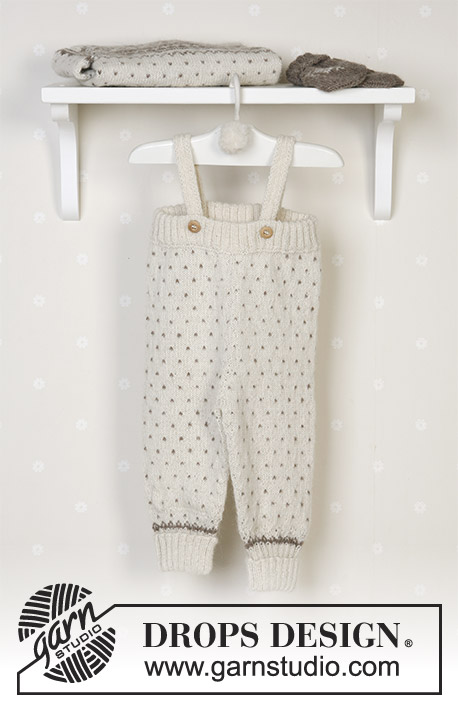


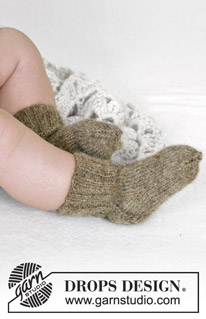
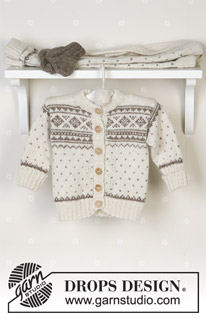
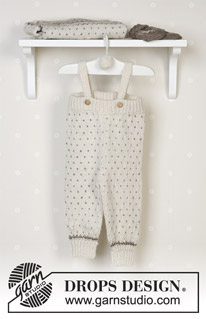















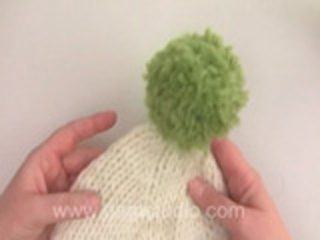





























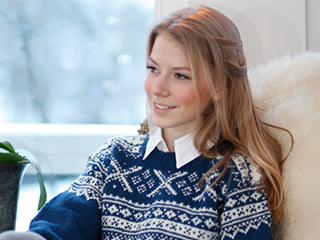




















Comments / Questions (116)
Bij het aantal steken voor de mouwen staat bij maat 6/9 maanden 53 steken opzetten m.i.z moet dit zijn 52 steken. Met vriendelijke groet, Greet Pater
25.08.2014 - 19:28DROPS Design answered:
Hoi Greet. Je hebt gelijk. Ik heb het patroon aangepast. Bedankt voor het melden.
27.08.2014 - 15:46Guten Tag, ich stricke Jacke und bin an der Stellen, an der ich das Muster 2 bis zu einer Länge von 25 cm ( 2 Jahre) stricken soll. Nun soll ich mit Muster 3 weiterstricken und bei 24 cm die Armlöcher einarbeiten? Die Jacke ist doch schon 25 cm. Viele Dank für Ihre Hilfe.
07.04.2014 - 18:48DROPS Design answered:
Liebe Dana, die Reihenfolge ist so angegeben, weil bei den kleineren Größen tatsächlich zuerst zu M.3 gewechselt wird und dann die Armausschnitte gearbeitet werden. In Ihrer Größe arbeiten Sie die Armausschnitte jedoch bereits bei einer Länge von 24 cm ein, stricken dann bis zu einer Länge von 25 cm mit M.2 weiter (Rückenteil und Vorderteile) und wechseln dann zu M.3.
08.04.2014 - 23:27Eine Frage zu den Ärmeln habe ich jetzt richtig gelesen ? die Ärmel werden diesmal in der Mitte zugenommen und nicht am Rand ????
29.12.2013 - 20:45Hallo! Wenn ich die Anleitung richtig lese beginne ich in diesen Fall mit einer Rückreihe die Muster zustricken. Ist das so richtig? Es wäre vieleicht hilfreich wenn bei den Mustersätzen zumindest am Anfang die Reihen zahlenmäßig gekennzeichnet sind z.B. 1 rechts und 2 links. Vielen Dank und Frohe Weihnachten
20.12.2013 - 10:31DROPS Design answered:
Liebe Gabriele, sofern nichts anderes erwähnt ist, werden unsere Diagramme ab der rechten untere Ecke gelesen (und die erste R ist eine Hin-R).
20.12.2013 - 15:20Vraag bij extra ruimte bij broekje. Ik snap niet helemaal wat er wordt bedoeld. 10 steken breien, werk keren, 1 afhalen en dan 20 breien. Moet ik dan eerst die 10 steken weer av. breien en op de volgende naald 20 steken breien? Weer terug en dan herhalen?
01.12.2013 - 22:59DROPS Design answered:
Hoi Kirsten. Je breit een verhoging. Dus eerst brei je 10 st, keer en brei 20 st (dus je breit over de eerste 10 st die je net hebt gebreid inderdaad en dan 10 st verder).
02.12.2013 - 12:38Stitch count after instep shaping confuses me. -44 sts, decreased to 40 sts -3cm heel flap, 32 sts -picked up 7 sts each side to 46, but am confused what the "upper 18 sts" mean. Typcially I decrease after/before 7 picked up sts leaves 24 sts across the upper foot. If I start toe decreases there is no way I end up with enough sts on 1st and 3rd needles to decrease 2 sts per round for 7 rounds.
24.10.2013 - 13:40DROPS Design answered:
Dear Trish, when you work heel, you put 24 sts for upper foot aside. You will then dec for instep inside the 18 sts (in the middle of these 24 sts). You dec 7 times every other row, ie 14 rows, with a tension of 32 rows garter st for 10 cm, dec for instep will be 4 cm long. You start toe 8 cm after toe decrease. Happy knitting!
24.10.2013 - 14:31Hei!tror dere det vil fungere å strikke bolen rundt i stedet for frem og tilbake, for så å klippe opp etterpå?
11.09.2013 - 18:01DROPS Design answered:
Hej Maria Therese. Det tror jeg godt du kan, men husk at du skal da strikke stolperne dobbelt saa de kan foldes om sömmen midt for. God fornöjelse.
12.09.2013 - 10:58Hei, lapasten suomenkielisessä ohjeessa kuvion teosta sanotaan: " lankaa ei tarvitse liittää mukaan koko neuleen ympäri, vain edestakaisin mallineule-s:illa" Miten tämä käytännössä tehdään kun neulotaan suljettua neuletta? Jos ymmärsin oikein vastauksen norjankieliseen kysymykseen, suosittelette kuitenkin kuviolangan kuljettamista mukana?
14.03.2013 - 12:58DROPS Design answered:
Kyllä, suosittelemme että kuviolankaa kuljetetaan työn mukana koko mallineuleen ajan, jolloin työstä tulee siistimpi, kuin jos lankoja katkaistaisiin.
15.03.2013 - 14:26Hei! Skal begynne på vottene nå, men stusser litt på mønsteret. Hvordan skal man gjøre når man ikke skal ta med seg tråden helt rundt?
17.01.2013 - 10:52DROPS Design answered:
Jeg ville nok strikke fair-isle hele vejen rundt paa votten naar du strikker M.5. Det er nemmere og paenere i stedet for at skulle klippe traaden og starte paany ved hver pind. Se i vores video index hvordan du strikker fair-isle.
17.01.2013 - 11:43Ich stricke die Faeustlinge es steht in der Anleitung, dass beim Muster die Faeden nicht um die ganze Arbeit herumgestrickt werden muessen, sondern nur hin und zurück über die Mustermaschen eingestrickt werden muessen. Wie mache ich das, wenn ich doch die Arbeit auf dem Nadelspiel rund stricke und nicht hin und zurueck? Danke!
05.12.2012 - 04:42DROPS Design answered:
Liebe Barbara, da der Mustersatz nur über ein paar Maschen geht, nehmen Sie den Faden nicht über die ganze Runde mit, sondern lassen ihn hängen und nehmen ihn über die Maschen zurück, wenn Sie in der nächsten Runde wieder an der Stelle des Musters angekommen sind. Sie könnten die Spannfäden zum Schluss etwas anheften, damit die Fingerchen sich nicht darin verfangen.
06.12.2012 - 12:12